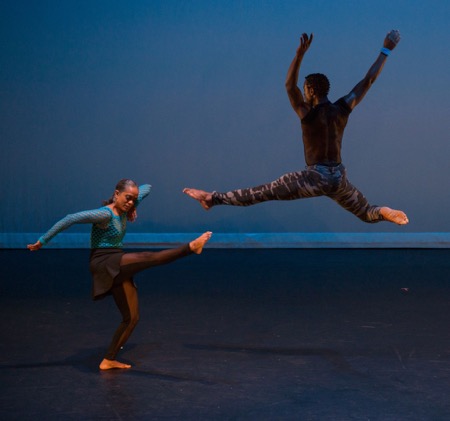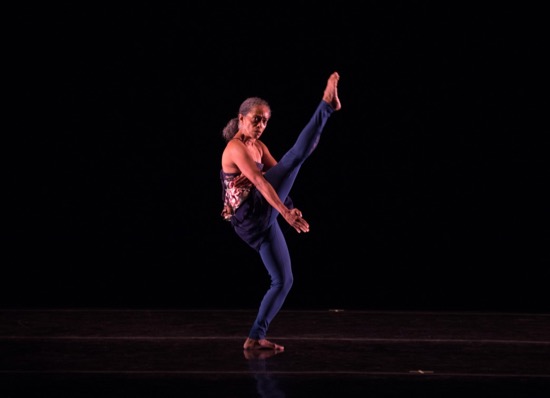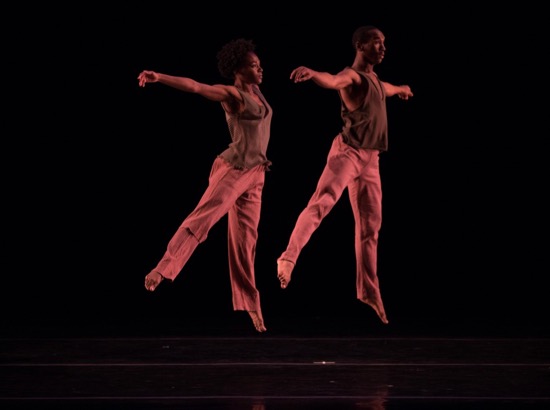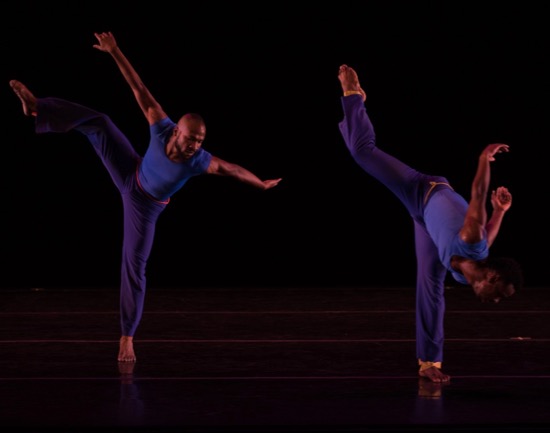Garth Fagan Dance comes from Rochester to the Joyce Theater, November 7 through 12.

A composite of dancers in Garth Fagan’s In Conflict: (L-R) Wynton Rice and Sarah Herbert, Vitolio Jeune, Natalie Rogers, Le’Tiger Walker, and Nina Price. Photo: Erich Camping
This isn’t the first time I’ve wanted to start a review of Garth Fagan Dance by praising the dancers. It’s not, however, really fair. They’ve been intensively trained by Fagan at his school up in Rochester, New York, and they’re dancing either his choreography or that of company member Norwood Pennewell (now the company’s rehearsal director and Fagan’s assistant). Still, whatever the multiple causes, they move in ways that differ from other dancers that I’ve seen. Fagan’s own roots are Jamaican, and his dancers have mobile hips and shoulders; they play soft, quick heel-and-toe games with the floor; their arms swing, their elbows wing out. But anything to do with a particular culture has been subsumed into the company’s distinctive style. Consider their phenomenal ability to strike a balance on one leg instantly, the other leg lifted high to the side and kept there for a while like laundry hung out to dry. Or a flag. They vault sideways high into the air, splitting their legs apart as they do so. No fanfare, no rush, no visible effort. Cool heat.
Fagan’s 2013 duet, No Evidence of Failure, depicts a relationship that differs from both classical pas de deux and certain contemporary couple dances. It begins with a solo by the magnificent Natalie Rogers, who has been in the company since 1989 (gray hair in her ponytail? So what). To music by jazz artist Monty Alexander, Rogers makes the stage into her territory—a place to examine, a place in which to test fast, skittery steps against lazier moments. She can try out a leap, arch her body back, shift her shoulders around, and (this is a nice little joke) stick a leg into the air, and lay one cheek on her hand. If herons can sleep on one leg, why not a hardworking human?

Natalie Rogers and Vitolio Jeune of Garth Fagan Dance in Fagan’s No Evidence of Failure. Photo: Rosalie O’Connor
Vitolio Jeune runs in, looks around, does a bit of leaping and spinning and shaking himself before approaching her very gently, nudging in. Their partnership has none of that hold-my-finger-and-help-me-spin stuff; no pseudo-sexual tangles either. These two may leap in unison or challenge each other, but they also stay close—warm and considerate, finding ways to nestle together, their cheeks touching. Once, having completed a joint maneuver, she gives him several little pecking kisses. Later he, who joined the company about twenty years later than she did, kisses her hands.

Natalie Rogers in Garth Fagan’s Estrogen/Genius. Photo: Rosalie O’Connor
Fagan’s world premiere during the Joyce season brings out something else that’s not all that common: the strength of his women. I’ve forgotten now in which piece one of them toted a man somewhere, but their strength is also strength of character. The new work, titled Estrogen/Genius, is also headed by Rogers, but her companions—Adriene B. Hodge, Sarah Herbert, Nina Price, and Rishell Maxwell—are a tight bunch. It’s not surprising that, just before the end, when they advance toward us, they stand in a back-to-back clump, elbows linked. Knock them down? Not a chance. But they also dance vigorously, athletically, carving out their turf together or in pairs or alone. It’s perhaps ironic that they dance to three songs by the seven-man vocal ensemble “Naturally 7” from the album Hidden in Plain Sight. One of the songs, “Fix Me” advises that “If you never try, you’ll never know. . . .” Freedom? Empowerment? These women look as if they can define those for themselves.

Rishell Maxwell (L) and Le’Tiger Walker in Norwood Pennewell’s A Moderate Cease, Photo: Rosalie O’Connor
Pennewell, beginning in 1978 as one of Garth Fagan Dance’s most terrific dancers, has been choreographing since 2010. His movement vocabulary draws on what he learned from Fagan, but A Moderate Cease (2016), which opened the program, offered him a new challenge: he set it to William Walton’s 1956 Cello Concerto. I don’t know the music well, so I’m not sure Pennewell used all of it, even though his dance seemed a bit long (the score runs about twenty-eight minutes). His choreography doesn’t follow the musical phrases closely; it runs alongside Walton’s lovely river of sound, dipping into it here and there (alas, played at what seemed excessively loud volume, that “river” sometimes became an obtrusive torrent).
The six dancers have a lot in common (i.e. as an ensemble, they run in place, leap side, begin and end in a circle), but they also have breakouts and close relationships. Hodge, a splendid dancer who joined the company three years ago, comes across as a loner, threading her way through the piece, aware of the others even when when not joining them. Pennewell’s choreography pits two performers (Maxwell and Le’Tiger DeAnte’ Walker) against three (Price, Jeune, and Guy Thorne)—beautiful dancers all. The two groups at first succeed each other on stage, but at one point, lighting designer Lutin Tanner emphasizes their contrapuntal nature by splitting the stage into two zones, one set of dancers warmly lit, the other chill.
Since this was the first dance on the program, it introduced us to the sight of these dancers’ ability to leap high and land on one leg, tilted and balanced, without a single after-shock (gasp!). I also detected—or thought I did—a looseness in certain throw-away gestures that struck me as slightly more Pennewellian than Faganish.

Guy Thorne (L) and Vitolio Jeune of Garth Fagan Dance in Norwood Pennewell’s Wecoo Duende. Photo: Rosalie O’Connor
Pennewell’s world premiere at the Joyce is titled Wecoo Duende. I only know “Wecoo” as an international construction company, but “Duende,” the poet Federico Garcia Lorca knew it well —that deep, mysterious spirit that may possess, say, a great flamenco dancer. The music that Pennewell chose is a recording by Doudou N’Diaye Rose Orchestra of compostions by its Senegalese percussionist founder and includes fames kora player Seiku Keita. Wecoo Duende has a larger cast than A Moderate Cease: ten dancers—five men and five women—all of them handsomely costumed by Keiko Voltaire.
The atmosphere is tribal without being specifically African. But we also see the huge leaps and kicks and spins accompanied by trickier heel-and-toe work, the dancer’s knees turning in and out, their bodies hunkering down, their arms swinging. And here too, on occasion, Pennewell chooses to juxtapose slow movement to more rapid rhythms (I think of a brief solo by Maxwell). He also gives us a chance to focus on certain dancers: Herbert, say, duetting with Andrew David O’Brian; Davente Gilreath, like O’Brian, appearing for the first time in the evening. Rogers, Jeune, Thorne, Hodge, Price, Walker, in addition to the above, include us in their spirited, athletic rite and bow to us when they’re done, just as the music ends.
That’s not all folks. Garth Fagan Dance doesn’t shy away from long programs with two intermissions. As a bonus, everybody sprints onstage into an excerpt from Fagan’s expertly organized 2002 Translation Tradition, set to music by Jazz Jamaica All Stars and by Harry Johnson. Not only does Pennewell himself toss his tall, slim self into the action, but Steve Humphrey (gray beard, gray topknot), who has danced in the company for forty-one years, launches himself into barrel turns. Lord, how they all dance! And, lifted by applause, they still have enough energy and devotion to repeat some of what they just did. God forbid we should go home hungry.

Deborah, How exciting to read your words about Garth Fagan Dance. I lived in Rochester in the 1990s and was fortunate to see the company many times then, but not since. To know that Natalie Rogers is still dancing — wow. Not to mention Norwood Pennewell and the magnificent Steve Humphrey! We always said that Garth trains his dancers to avoid injury, and the length of these people’s careers — including Garth himself — is testament to that. Thank you.